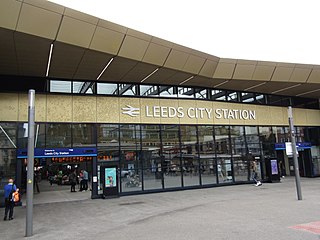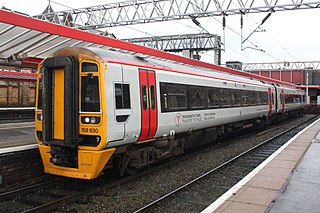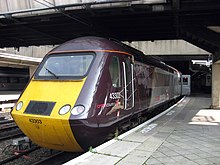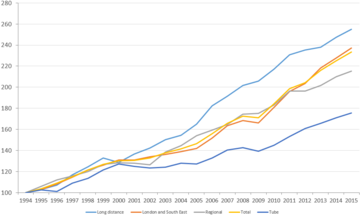
The railway system in Great Britain is the oldest railway system in the world. The first locomotive-hauled public railway opened in 1825, which was followed by an era of rapid expansion. Most of the track is managed by Network Rail, which in 2017 had a network of 15,811 kilometres (9,824 mi) of standard-gauge lines, of which 5,374 kilometres (3,339 mi) were electrified. These lines range from single to quadruple track or more. In addition, some cities have separate metro, light rail and tram systems. There are also many private railways, which are primarily short lines for tourists. The main rail network is connected with that of continental Europe by the Channel Tunnel and High Speed 1, which fully opened in 1994 and 2007 respectively.

Transport in the United Kingdom is facilitated with road, air, rail, and water networks. A radial road network totals 29,145 miles (46,904 km) of main roads, 2,173 miles (3,497 km) of motorways and 213,750 miles (344,000 km) of paved roads. The National Rail network of 10,072 route miles (16,116 km) in Great Britain and 189 route miles in Northern Ireland carries over 18,000 passenger and 1,000 freight trains daily. Urban rail networks exist in Belfast, Birmingham, Cardiff, Edinburgh, Glasgow, Liverpool, London, Manchester and Newcastle. There are many regional and international airports, with Heathrow Airport in London being one of the top ten busiest in the world. The UK also has a network of ports which received over 486 million tons of goods in 2019. Transport is the largest source of greenhouse gas emissions by the United Kingdom.

Leeds railway station is the mainline railway station serving the city centre of Leeds in West Yorkshire, England. It is the fourth-busiest railway station in the UK outside London. It is located on New Station Street to the south of City Square, at the foot of Park Row, behind the landmark Queens Hotel. It is one of 20 stations managed by Network Rail.

InterCity was introduced by British Rail in 1966 as a brand-name for its long-haul express passenger services.
FirstGroup plc is a British multi-national transport group, based in Aberdeen, Scotland. The company operates transport services in the United Kingdom and Ireland. It is listed on the London Stock Exchange and is a constituent of the FTSE 250 Index.
A train operating company (TOC) is a business operating passenger trains on the railway system of Great Britain under the collective National Rail brand. TOCs have existed since the privatisation of the network under the Railways Act 1993.

The British Rail Class 158Express Sprinter is a diesel multiple unit (DMU) passenger train. It is a member of the Sprinter series of regional trains, produced as a replacement for British Rail's first generation of DMUs; of the other members, the Class 159 is almost identical to the Class 158, having been converted from Class 158 to Class 159 in two batches to operate express services from London Waterloo to the West of England.

The British Rail Class 153Super Sprinters are single-coach railcars converted from two-coach Class 155 diesel multiple units in the early 1990s. The class was intended for service on rural branch lines, either where passenger numbers do not justify longer trains or to boost the capacity on services with high passenger volume.
The Wakefield line is a railway line and service in the West Yorkshire Metro and South Yorkshire Passenger Transport Executive areas of northern England. The Wakefield line is coloured yellow on maps and publications by West Yorkshire Metro. The line was electrified in 1989, between Leeds & Wakefield Westgate, as part of the programme to electrify the East Coast Main Line.
Cross Country services on the British rail network carry passengers between regions on routes avoiding London termini.

The South Wales Main Line, originally known as the London, Bristol and South Wales Direct Railway or simply as the Bristol and South Wales Direct Railway, is a branch of the Great Western Main Line in Great Britain. It diverges from the core London-Bristol line at Royal Wootton Bassett beyond Swindon, first calling at Bristol Parkway, after which the line continues through the Severn Tunnel into South Wales.

Lincoln railway station serves the city of Lincoln in Lincolnshire, England. The station is owned by Network Rail and managed by East Midlands Railway. East Midlands Railway provides the majority of services from the station, with other services being provided by Northern and London North Eastern Railway.

England has a dense and modern transportation infrastructure. The Department for Transport is the government department responsible for the English transport network. Transport in England is facilitated with road, air, rail, and water networks. A radial road network totals 29,145 miles (46,904 km) of main roads, 2,173 miles (3,497 km) of motorways and 213,750 miles (344,000 km) of paved roads.
The transport system in Scotland is generally well-developed. The Scottish Parliament has control over most elements of transport policy within Scotland, with the Cabinet Secretary for Transport, Infrastructure and Connectivity holding portfolio responsibility within the Scottish Government. Transport Scotland is the Executive Agency responsible for the Scottish transport network.

High-speed rail in the United Kingdom is provided on five upgraded railway lines running at top speeds of 125 mph (200 km/h) and one purpose-built high-speed line reaching 186 mph (300 km/h).

CrossCountry is a train operating company in the United Kingdom owned by Arriva UK Trains, operating the Cross Country franchise.

Urban or suburban rail plays a key role in public transport in many of the United Kingdom's major cities. Urban rail refers to the train service between city centres and suburbs or nearby towns that acts as a main mode of transport for travellers on a daily basis.
After extensive privatisation of the public sector during the Margaret Thatcher administration, there remain few statutory corporations in the UK. Privatisation began in the late 1970s, and notable privatisations include the Central Electricity Generating Board, British Rail, and more recently Royal Mail. After the Hatfield rail crash accident, the British government decided to intervene and in 2002 renationalised Railtrack into Network Rail.
An operator of last resort is a business in the United Kingdom that operates a railway franchise, on behalf of the government, when a train operating company is no longer able to do so. As of April 2022, there are five such operators in England, Wales and Scotland.














